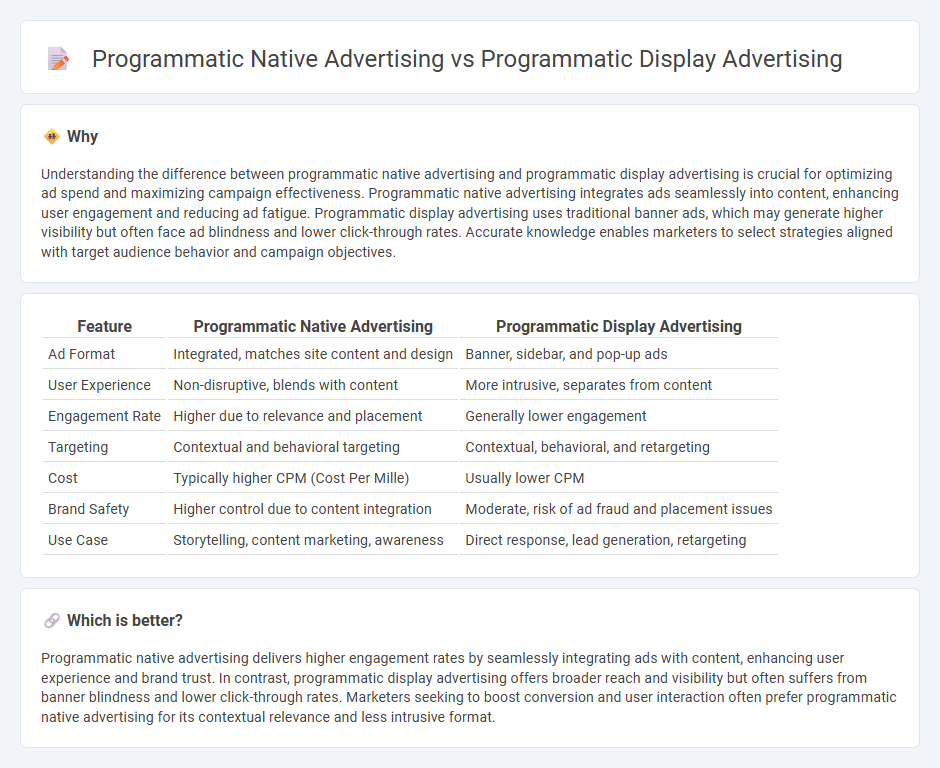
Programmatic native advertising seamlessly integrates promotional content within the user's browsing experience, driving higher engagement through relevance and subtlety. Programmatic display advertising uses automated technology to buy and place banner ads at scale, focusing on visibility and broad audience reach. Discover how each method can elevate your marketing strategy and boost conversion rates.
Why it is important
Understanding the difference between programmatic native advertising and programmatic display advertising is crucial for optimizing ad spend and maximizing campaign effectiveness. Programmatic native advertising integrates ads seamlessly into content, enhancing user engagement and reducing ad fatigue. Programmatic display advertising uses traditional banner ads, which may generate higher visibility but often face ad blindness and lower click-through rates. Accurate knowledge enables marketers to select strategies aligned with target audience behavior and campaign objectives.
Comparison Table
| Feature | Programmatic Native Advertising | Programmatic Display Advertising |
|---|---|---|
| Ad Format | Integrated, matches site content and design | Banner, sidebar, and pop-up ads |
| User Experience | Non-disruptive, blends with content | More intrusive, separates from content |
| Engagement Rate | Higher due to relevance and placement | Generally lower engagement |
| Targeting | Contextual and behavioral targeting | Contextual, behavioral, and retargeting |
| Cost | Typically higher CPM (Cost Per Mille) | Usually lower CPM |
| Brand Safety | Higher control due to content integration | Moderate, risk of ad fraud and placement issues |
| Use Case | Storytelling, content marketing, awareness | Direct response, lead generation, retargeting |
Which is better?
Programmatic native advertising delivers higher engagement rates by seamlessly integrating ads with content, enhancing user experience and brand trust. In contrast, programmatic display advertising offers broader reach and visibility but often suffers from banner blindness and lower click-through rates. Marketers seeking to boost conversion and user interaction often prefer programmatic native advertising for its contextual relevance and less intrusive format.
Connection
Programmatic native advertising and programmatic display advertising are connected through their use of automated technology to purchase and optimize ad placements in real time. Both leverage data-driven algorithms to target specific audiences, enhancing ad relevance and campaign efficiency across digital platforms. The primary difference lies in ad format, with native ads seamlessly integrating into content while display ads appear as traditional banners or visuals.
Key Terms
Real-Time Bidding (RTB)
Programmatic display advertising utilizes Real-Time Bidding (RTB) to automate the purchase of ad impressions as users load web pages, optimizing banner and video ad placements for maximum reach and efficiency. Programmatic native advertising also leverages RTB but focuses on seamlessly integrating ads within content feeds, enhancing user experience by matching the look and feel of the surrounding editorial environment. Explore the differences and advantages of RTB-driven programmatic strategies to boost your advertising ROI.
Ad Creative Format
Programmatic display advertising primarily uses standard banner ads, which are visually distinct from webpage content and offered in fixed sizes like 300x250 or 728x90 pixels, enhancing visibility but potentially causing banner blindness. Programmatic native advertising integrates ads seamlessly into content streams with formats such as in-feed units or recommendation widgets, boosting user engagement by matching the surrounding editorial style and user experience. Explore deeper insights on how ad creative formats influence campaign effectiveness and user interaction rates.
Audience Targeting
Programmatic display advertising uses automated bidding to place banner ads on websites, targeting audiences based on demographics, behavior, and browsing history for broad visibility. Programmatic native advertising integrates promotional content seamlessly within the user experience, leveraging advanced audience segmentation and contextual signals to deliver highly relevant ads that match the format and tone of the host platform. Explore deeper insights on how these strategies optimize audience targeting for advertisers seeking precise engagement.
Source and External Links
What is Programmatic Display Advertising? - Setupad.com - Programmatic display advertising automates buying and selling ad space using AI and machine learning, targeting users based on demographics, behavior, and interests for efficient, real-time ad placements on websites and apps.
Programmatic Advertising - What It Is and How It Works - Amazon Ads - Programmatic advertising uses automated technology to buy and sell digital ads across web, mobile, apps, video, and social media, delivering relevant ads in real-time through algorithmic bidding and optimization.
Programmatic vs. Native Display Advertising - Nativo - Programmatic advertising automates ad space buying in real-time auctions, using algorithms to target audiences based on browsing habits, demographics, and location, enabling advertisers to reach vast audiences efficiently.
 dowidth.com
dowidth.com